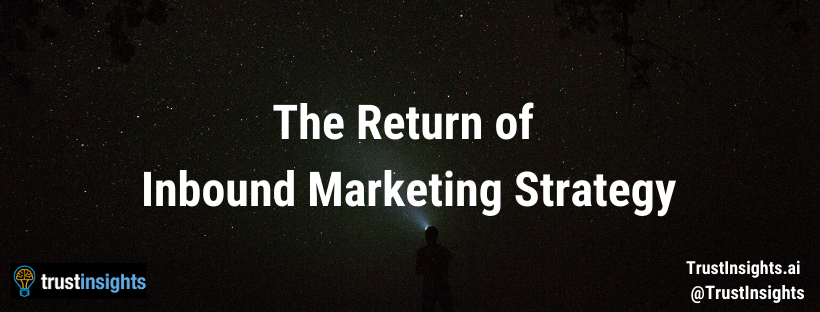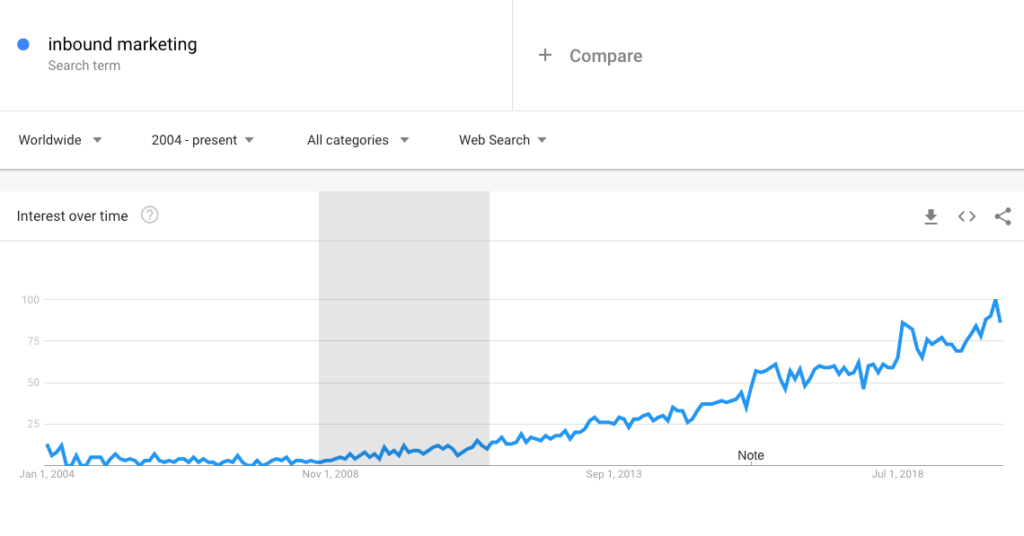Inbound marketing was created out of necessity. Back in 2006, Brian Halligan and Dharmesh Shah started Hubspot and championed the concept of inbound marketing, the idea that customers would use digital technologies to seek companies out, rather than companies chasing potential customers. The promises of inbound marketing were lower costs and better quality customers, because customers would self-select to do business with companies that best matched their needs. For the first few years, not much happened on the inbound marketing front.
What really brought the concept of inbound marketing to prominence was the confluence of three factors: Search engine optimization (SEO), social media, and the Great Recession. SEO and social media gave companies the ability to be found and interact with customers, but it wasn’t until the Great Recession – 2008-2011 – that companies embraced inbound marketing.
Figure 1. Global searches for inbound marketing, 2004-2020. The dark grey box indicates the period of the Great Recession.
Why? Because inbound marketing had fewer hard dollar costs, and that was gold in the Great Recession. Publishing content for search engines and social networks like Twitter (which launched in 2007) have substantial soft dollar costs – time, effort, etc. – but once done, have relatively few hard dollar costs. That pivot, to soft dollar marketing costs, is what allowed many companies to survive and thrive in the Great Recession, when marketing dollars were scarce. It allowed smaller, more nimble businesses to catch up and beat larger competitors, and it let companies willing to invest soft dollar costs reap rewards in hard dollars.
After the recession, companies found balance. Social networks started charging money – a lot more money – to advertise to users. SEO became driven by powerful, AI-based algorithms that made early tricks of the trade counterproductive. As profitability increased, marketing budgets ballooned, and spending money was no longer the taboo it was during the Great Recession. The world became digital as the smartphone conquered everything.
Inbound Marketing Today
Today, we’re standing in the middle of another massive disruption. Marketing dollars are again becoming scarce. Job losses are hitting record highs. Companies are retrenching and working to determine what their marketing strategy should be, but chances are it’s not going to involve just simply handing our corporate credit cards to Mark Zuckerberg. Ad spending is sharply down across the board; in the Q2 earnings calls, companies like Google and Facebook have warned investors of double-digit declines in ad spend, billions of dollars no longer on the table. ROI is sexy again after a decade of “growth at any cost”.
Amidst this, search, social media, and messaging are still driving business to companies. Organic search still costs few hard dollars, and social media – if marketers are smart and clever – can still deliver solid returns on investment even for unpaid social, as long as you’re in one of the niche social networks.
What does this mean for you and me? It means a return to inbound marketing. Inbound Marketing 2.0, if you will, powered by a very different digital media landscape than in 2008-2011, but underpinned by the same core inbound marketing strategy:
Marketing costs less and works better if customers come to you, rather than you chasing them.
So, what does that look like today? It all comes back to where our customers are.
Inbound Marketing 2.0: Search Engine Optimization
SEO in the new world is driven by artificial intelligence and its ability to understand the content you’re producing. Creating relevant, timely, targeted content that answers key questions by audiences to demonstrate expertise, authority, and trust is not news in the world of search engine optimization, but the ability for AI to better understand and tune its results to rich content marketing is. SEO in Inbound Marketing 2.0 couples creativity with the power of machine learning to reverse engineer search engine results and give both humans and machines exactly what they want – content marketing that shares incredible value.
Inbound Marketing 2.0: Social Media
Social media is more than just Facebook, Instagram, and Tiktok. Hundreds of social networks exist, from giants like YouTube to niches like Spiceworks. Extracting performance out of social media and social networks with Inbound Marketing 2.0 requires deep understanding of where your customers spend their time talking to others, and whether it’s appropriate for your company to be in those places. Hundreds of niche social networks exist that have smaller, dedicated, highly-focused audiences that would value appropriate conversations with the right companies.
Inbound Marketing 2.0: Messaging
In the early 2010s, one to one communications with short messages became one of the most prominent ways to stay in touch, with apps like WeChat, WhatsApp, Kik, Line, Tango, Viber, and many others growing their user bases. Today, messaging (including machine-powered messaging, or chatbots) is one of the dominant forms of interpersonal and small group communications. Inbound Marketing 2.0 recognizes the vital importance of being available to customers to chat with them when and where they want; chatbots make this level of responsiveness possible. And the grandfather of digital marketing messaging, email marketing, remains not only relevant, but one of the best ways to reach out to your audience.
Inbound Marketing 2.0: Communities
From the halcyon days of bulletin boards, IRC, and forums to modern-day communities like Slack, Discord, Mattermost, and social networking groups on major services, communities have been an integral part of the digital experience. Today, these communities – many of them private and invisible to marketers without invitation – are where decision-makers spend their time. Inbound Marketing 2.0 places a premium on becoming a part of or operating your own communities to retain loyal audience members and share value with them.
Inbound Marketing 2.0: Marketing Analytics
The greatest change since the Great Recession is the ubiquitousness of data and analytics. In the Great Recession, tools like Google Analytics were primitive and difficult to extract data out of. Attribution analysis was non-existent, and the idea of proving ROI was a pipe dream. In today’s Inbound Marketing 2.0 environment, data is rich and thorough, analysis is better than it’s ever been, and drawing insights from data is empowered with machine learning and artificial intelligence. As companies demand more performance and accountability from Inbound Marketing 2.0, advanced marketing analytics will be the decider for who succeeds.
Fixing Bad Marketing Habits
We developed many, many bad habits in the last decade. Digital marketing ad prices were so low for so long that we got in the habit of simply spending our way out of marketing problems. That won’t work in a scarce, small budget environment.
A consequence of “spend until we win” is that we truly neglected and abandoned actual interactions with our customers. Social media became broadcast media instead of a place to talk to other human beings, though recent times have changed that at the personal level for many.
And in the frenetic pace of an ever-changing world, many of us didn’t keep up with professional development and training. Knowledge of how SEO works, how social media algorithms choose what gets seen, how private communities operate best, and other digital practices are years behind what’s current best practices for many marketers. Transcending stale knowledge will be imperative to making Inbound Marketing 2.0 work for you.
Inbound Marketing Strategy Remains the Same
How we do inbound marketing changes, but the spirit of inbound marketing strategy remains the same: customers chasing us is far better than us chasing customers. From proper SEO to niche social media to chatbots and managed communities, we have everything we need to make today’s Inbound Marketing 2.0 deliver high value, high ROI, and impressive marketing performance. What holds us back are bad habits and stale ideas.
If you want to survive and succeed in the new, next normal, re-embrace core inbound marketing strategy. Create such great value that customers must chase you, whether that value comes from content marketing, from products that amaze, from service that delights, from values that inspire – however your customers appreciate value, make it your mission to over-deliver and start the chase. That’s how you’ll keep your budgets under control and still deliver great results.
|
Need help with your marketing AI and analytics? |
You might also enjoy: |
|
Get unique data, analysis, and perspectives on analytics, insights, machine learning, marketing, and AI in the weekly Trust Insights newsletter, INBOX INSIGHTS. Subscribe now for free; new issues every Wednesday! |
Want to learn more about data, analytics, and insights? Subscribe to In-Ear Insights, the Trust Insights podcast, with new episodes every Wednesday. |







